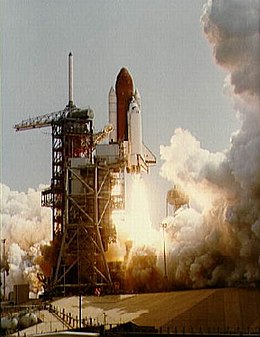STS-4

Columbia begins its final test flight from Launch Complex 39A of KSC
|
|
| Mission type | Test flight |
|---|---|
| Operator | NASA |
| COSPAR ID | 1982-065A |
| SATCAT № | 13300 |
| Mission duration | 7 days, 1 hour, 9 minutes, 31 seconds |
| Distance travelled | 4,700,000 kilometres (2,900,000 mi) |
| Orbits completed | 113 |
| Spacecraft properties | |
| Spacecraft | Space Shuttle Columbia |
| Launch mass | 109,616 kilograms (241,662 lb) |
| Landing mass | 94,774 kilograms (208,941 lb) |
| Payload mass | 11,109 kilograms (24,491 lb) |
| Crew | |
| Crew size | 2 |
| Members |
Thomas K. Mattingly II Henry W. Hartsfield, Jr. |
| Start of mission | |
| Launch date | 27 June 1982, 15:00:00 UTC |
| Launch site | Kennedy LC-39A |
| End of mission | |
| Landing date | 4 July 1982, 16:09:31 UTC |
| Landing site | Edwards Runway 22 |
| Orbital parameters | |
| Reference system | Geocentric |
| Regime | Low Earth |
| Perigee | 295 kilometres (183 mi) |
| Apogee | 302 kilometres (188 mi) |
| Inclination | 28.5 degrees |
| Period | 90.3 minutes |
 Hartsfield (left) and Mattingly |
|
STS-4 was the fourth NASA Space Shuttle mission, and also the fourth for Space Shuttle Columbia. The mission launched on 27 June 1982 and landed a week later on 4 July. STS-4 was the final test flight for the shuttle; it was thereafter officially declared to be operational. Columbia carried numerous scientific payloads during the mission, as well as military missile detection systems.
STS-4, being the last test flight of the Space Shuttle, was also the last to carry a crew of two astronauts. Commander Ken Mattingly had previously flown as Command Module Pilot on Apollo 16, and was also the original Command Module Pilot for Apollo 13 before being infamously replaced by his backup, Jack Swigert. Mattingly was also instrumental in returning the Apollo 13 crew safely back to Earth after the accident that prevented them from landing on the Moon. Hartsfield was a rookie who had transferred to NASA in 1969 after the cancellation of the Air Force's Manned Orbiting Laboratory program. He had previously served as a capsule communicator on Apollo 16, all three Skylab missions, and STS-1.
From STS-4 onwards, NASA halted the appointment and training of complete backup flight crews. Instead, individual flight crew members were assigned backups who could take their place within the prime crew. The decision on whether to appoint a reserve crew member was made on a per-flight basis by flight management teams at Johnson Space Center. Consequently, the last NASA flight to have a full-time backup crew was STS-3.
...
Wikipedia

